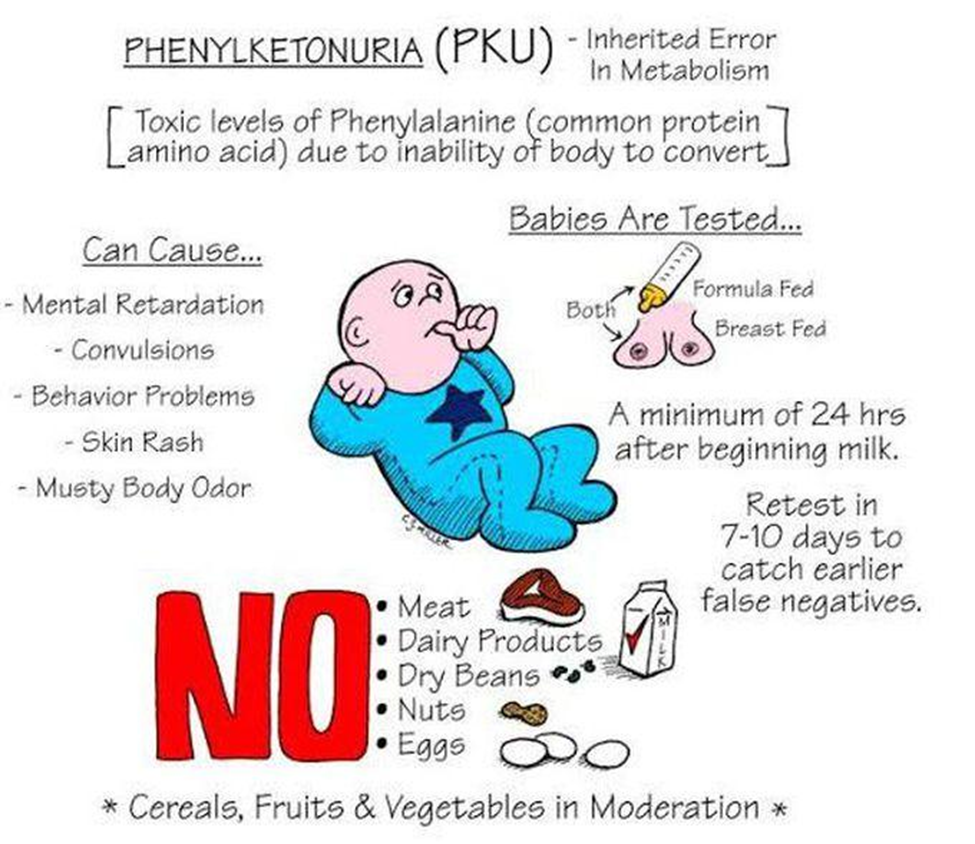A parent brings a 2-week-old infant to a clinic for a phenylketonuria rescreening blood test. The test indicates a serum phenylalanine level of 1 mg/dL (60.5 mcmol/L). The nurse reviews this result and makes which interpretation?
It is inconclusive
it is negative
it requires rescreening at age 6 weeks.
It is positive
The Correct Answer is B
A. It is inconclusive
Explanation: A serum phenylalanine level within the normal range is considered conclusive in ruling out phenylketonuria. Inconclusive results typically occur when there are issues with the sample or testing process.
B. It is negative
Explanation:
A serum phenylalanine level of 1 mg/dL (60.5 mcmol/L) in a 2-week-old infant is within the normal range. In the context of phenylketonuria (PKU) screening, a "negative" result means that the phenylalanine levels are within the expected range, and there is no evidence of phenylketonuria.
C. It requires rescreening at age 6 weeks.
Explanation: If the initial screening result is within the normal range, rescreening at age 6 weeks may not be necessary for phenylketonuria. The timing and need for rescreening may vary based on local protocols and individual patient factors.
D. It is positive
Explanation: A positive result for phenylketonuria would indicate that the serum phenylalanine levels are elevated, suggesting a potential diagnosis of PKU. In this case, the result is negative, meaning there is no evidence of PKU.

Nursing Test Bank
Naxlex Comprehensive Predictor Exams
Related Questions
Correct Answer is D
Explanation
A. Brachial artery:
Incorrect: The brachial artery is commonly used for measuring blood pressure in infants but not for assessing heart rate.
B. Radial artery:
Incorrect: The radial artery is not typically used for assessing an infant's heart rate, especially in the clinical setting.
C. Carotid artery:
Incorrect: The carotid artery is not commonly used for assessing an infant's heart rate. It is more commonly used in adults, but in infants, the apex of the heart is the preferred site.
D. Apex of the heart.
Correct Answer: The apex of the heart is the most accurate site for counting an infant's heart rate. It is located at the point of maximum impulse (PMI), which is usually at the fifth intercostal space in the mid-clavicular line.
Correct Answer is C
Explanation
A. A period of play in the playroom:
Incorrect: While play is generally therapeutic, simply engaging in general play may not directly address the child's distress related to the insulin injection.
B. A video game:
Incorrect: Playing a video game might serve as a distraction, but it may not specifically help the child cope with the distress of the injection in the way that hands-on play with a needleless syringe and a doll can.
C. A needleless syringe and a doll:
Correct Answer: Correct.
Explanation: Allowing the child to play with a needleless syringe and a doll provides a hands-on, interactive experience that can help the child become more familiar and comfortable with the idea of injections. This play activity allows the child to express and understand their feelings in a safe and controlled environment.
D. A story book about a child who has diabetes:
Incorrect: While a storybook can be educational and provide information, it may not directly address the child's immediate distress after an insulin injection. The hands-on play with a needleless syringe and a doll is more focused on the specific experience of receiving injections
Whether you are a student looking to ace your exams or a practicing nurse seeking to enhance your expertise , our nursing education contents will empower you with the confidence and competence to make a difference in the lives of patients and become a respected leader in the healthcare field.
Visit Naxlex, invest in your future and unlock endless possibilities with our unparalleled nursing education contents today
Report Wrong Answer on the Current Question
Do you disagree with the answer? If yes, what is your expected answer? Explain.
Kindly be descriptive with the issue you are facing.
